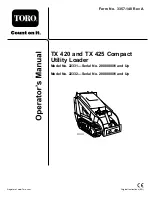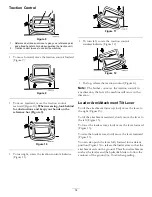
Traction Control
Figure 8
1.
Reference bar (does not move to give you a reference point
and a fixed handle to hold while operating the traction unit)
2.
Traction control (moves to control the machine)
•
To move forward, move the traction control forward
(Figure 9).
Figure 9
•
To move rearward, move the traction control
rearward (Figure 10).
When reversing, look behind
for obstructions and keep your hands on the
reference bar (Figure 9).
Figure 10
•
To turn right, rotate the traction control clockwise
(Figure 11).
G008131
Figure 11
•
To turn left, rotate the traction control
counterclockwise (Figure 12).
G008132
Figure 12
•
To stop, release the traction control (Figure 8).
Note:
The farther you move the traction control in
any direction, the faster the machine will move in that
direction.
Loader Arm/Attachment Tilt Lever
To tilt the attachment forward, slowly move the lever to
the right (Figure 13).
To tilt the attachment rearward, slowly move the lever to
the left (Figure 13).
To lower the loader arms, slowly move the lever forward
(Figure 13).
To raise the loader arms, slowly move the lever rearward
(Figure 13).
You can also push the lever fully forward into a detent
position (Figure 13) to release the loader arms so that the
attachment rests on the ground. This allows attachments
such as the leveler and the hydraulic blade to follow the
contours of the ground (i.e., float) when grading.
14
Содержание 22331 TX 420
Страница 7: ...Slope Chart 7 ...
Страница 48: ...Schematics Electrical Schematic Rev A 48 ...
Страница 49: ...Hydraulic Schematic Rev A 49 ...
Страница 50: ...Notes 50 ...
Страница 51: ...Notes 51 ...


































